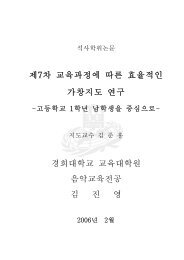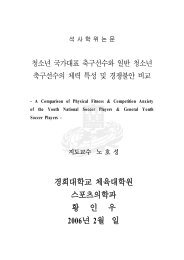P. gingivalis 에 대한 피톤치드의 항균효과
P. gingivalis 에 대한 피톤치드의 항균효과
P. gingivalis 에 대한 피톤치드의 항균효과
Create successful ePaper yourself
Turn your PDF publications into a flip-book with our unique Google optimized e-Paper software.
- A b s t r a c t -<br />
E f f e c t o f p h y t o n c i d e o n Po r p h y r o m o nas <strong>gingivalis</strong><br />
S u n - Q K i m , D.M.D., M.S.D.<br />
Department of Oral Medicine, Division of Dentistry, Graduate School, Kyung Hee<br />
University<br />
(Directed by Yang-Hyun Chun, D.M.D., M.S.D., Ph.D)<br />
Trees emit the phytoncide into atmosphere to protect them from predation. Phytoncide<br />
from different trees has its own unique fragrance that is referred to as forest bath.<br />
Phytoncide, which is essential oil of trees, has microbicidal, insecticidal, acaricidal, and<br />
deodorizing effect. The present study was performed to examine the effect of phytoncide<br />
on Porp hy rom onas <strong>gingivalis</strong>, which is one of the most important causative agents of<br />
periodontitis and halitosis. P. <strong>gingivalis</strong> 2561 was incubated with or without phytoncide<br />
extracted from Hinoki (C ham aec yp aris obtu sa Sieb. et Zucc.; Japanese cypress) and then<br />
changes were observed in its cell viability, antibiotic sensitivity, morphology, and<br />
biochemical/molecular biological pattern. The results were as follows:<br />
1. The phytoncide appeared to have a strong antibacterial effect on P. <strong>gingivalis</strong>. MIC<br />
of phytoncide for the bacterium was determined to be 0.008%. The antibacterial effect<br />
was attributed to bactericidal activity against P. <strong>gingivalis</strong>. It almost completely<br />
suppressed the bacterial cell viability (>99.9%) at the concentration of 0.01%, which<br />
is the MBC for the bacterium.<br />
2. The phytoncide failed to enhance the bacterial susceptibility to ampicillin, cefotaxime,<br />
penicillin, and tetracycline but did increase the susceptibility to amoxicillin.<br />
3. Numbers of electron dense granules, ghost cell, and vesicles increased with increasing<br />
concentration of the phytoncide,<br />
4. RT-PCR analysis revealed that expression of superoxide dismutase was increased in<br />
the bacterium incubated with the phytoncide.<br />
5. No distinct difference in protein profile between the bacterium incubated with or<br />
- 18 -

















